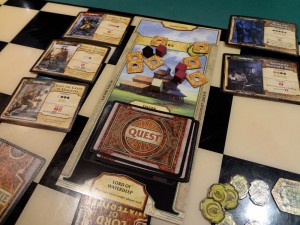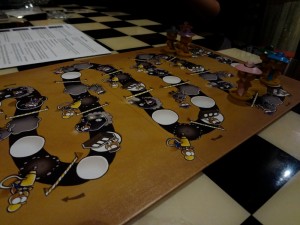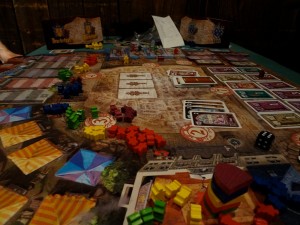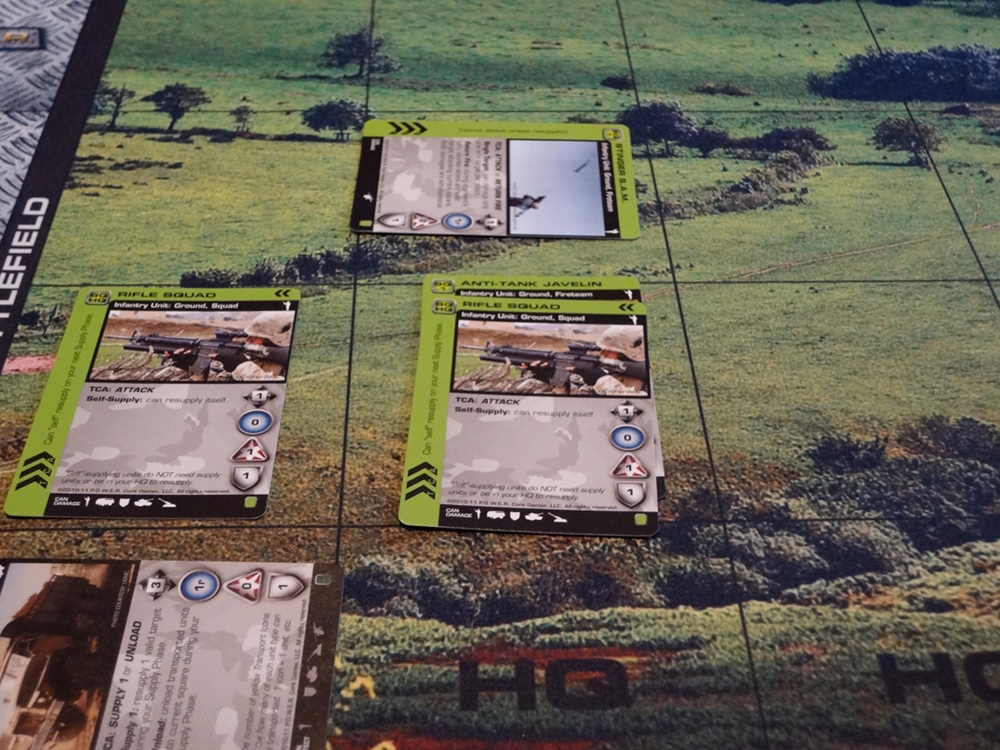Las Vegas Board Games Meetup – June 6, 2012
I got a taste on June 6 for what happens at the Las Vegas Board Games Group when founder Stephan Brissaud is in attendance. He circulated with name tags printed out using Meetup users’ icons, dispensed them, and then also sold raffle tickets for the drawing for Carcassone or one of four Kosmos Games on offer. Tickets were $1, but by buying them ahead of time on-line, attendees could obtain a re-roll of one of the dice. The winner won with a roll of 18 on 3d6.
Lemming Mafia
I had played through Lemming Mafia from Mayfair Games twice before learning that the game was actually called Lemming Mafia and not just Lemmings. Somehow, even though the spaces you land on have a mafia motif of bricking up the lemmings’ feet in concrete and gambling on the outcome of the race, I had missed how important Italian crime families are in the game. Basically you have a race between 6 lemmings. Each turn 2d6 are rolled and on the faces of each die are the six lemming colors. If you get two different lemmings, you can choose which one advances past the next hurdle. While the Juke Joint has dimmer lights than most play environments, I had a hard time associating the red lemming on the dice with the Maroonish Lemming that was supposed to be Red. The Grey and the Purple also confused me just a little, but it could have been the effects of the Guiness I was drinking.
We played it a second time after stumbling through a first game marked by a lot of confusion as there were very few experienced players. One player wisely abandoned ship for the second go-round. I thought the game would be easier and quicker the second time, but increased understanding of what we were trying to do possibly lengthened the game from players taking the time to think about the outcomes of each move.
While points can be gained from completing random mission objectives, up to 6 points can be won by correctly betting on which lemming will end up in first place. In our games, the “correct” bet seemed to play a large roll in determining the winner, but it also seemed more coincidental than intentional. Only certain spaces on the board allow the bets to be made and the more bets you have beneath your winning lemming color, the more points you gain. The missions have variable points. You might get 2 points if Purple places higher than Pink and then 2 points if either Purple or Green get “concreted” out. At the same time, since they’re random, it’s possible for one player to just get lucky and have a good hand with high values that get fulfilled. For each mission you don’t complete, you lose 2 points. There is also the opportunity for all players to ditch a mission card at several of the spaces on the board, if a lemming happens to land on one.
Even if the subject matter of Mafioso lemmings is questionable, its cartoonish style does seem geared towards children, as well as its basic play mechanics of how to move a lemming and the few choices of actions available each turn. On the other hand, scoring and actually winning at Lemming Mafia will be harder for a child to grasp. I will probably give Lemming Mafia/em> a pass in the future for the same reasons.
Colonia
Besides having never played it before and wanting to try it out, I was also taken in by Colonia’s large playing surface. Made by the German publisher Queen Games and designed by Dirk Henn, the game also features German and English text on the cards. Essentially Colonia is a mercantile resource management game. It also is a strong exercise in odds, predictions, gambling, and variables. The game has a ton of variables. In each of the game’s 6 weeks, someone flips a card which determines how many goods are distributed to the market stalls, how many artisans are willing to turn your raw goods into finished products, and how many ships leave the harbor. The roll of a die further randomizes what the crafters are willing to make for you on Market Day.
The variables go on though. At the beginning of each week, new Edicts are revealed to be voted upon by the players. Each of the four ships in the harbor can have very different cargo orders they want to fill and each ship is owned by a separate country or city, paying the player with their own currency. The game is won by relic purchasing in the market on the seventh day. The cost and victory points awarded from the relics, again, are random with each of the relics only purchasable in a particular currency. What I would have given for a money lender in Colonia! Our game actually did provide us with the opportunity to exchange currency twice through the successful passage of an Edict granting currency conversion.
The game is further complicated by the changing play order among the players, which happens on the second day each week at the alderhouse or town hall with the election of a new mayor. Players bid a hidden number of Meeples to send to the town hall, varying from 3 to 8. Woe betide the player who bids a higher number of Meeples than he has in reserve! Yeah, woe betide me. I think I was the only person who failed to correctly foresee my neccessary number of Meeples. I did this three times. The penalty is that you don’t get to vote on the Edicts and you go dead last throughout the week. This penalty is actually fairly large, since the game is shifting each week and going last you may not be able to rush your Meeples to a particular locale and wind up sitting on a mass of raw goods as I did one week.
When not electing a new mayor, the Meeples are trotting out to buy things at market for you or to go get your orders fulfilled. One of the things that I really liked about Colonia was that your raw goods and finished goods were represented with markers and they are persistent until they are used. On the other hand, I spent a good portion of the game frustrated because I didn’t have the right raw goods to bring to a crafter or the right finished goods to load aboard a ship. I really would have liked a Cataan-style allowance for trading with the other players. Instead in Colonia you kind of have to sit there and take it. The game isn’t quick either. Ours lasted 2-2.5 hours with three experienced players and two newbies. In the end, the scores seemed fairly close. The winner boasted 21, while second had 17. I had 15 along with a veteran and last place had 11.
Mathematically the game probably has 10-15 variables going on at the same time; it’s complex. Queen Games could easily say that no two games will ever be the same. I am slightly interested in playing Colonia again and this time really slowing any play decisions down to try to understand what effect my action will likely have. However with such an investment of play time, I would like to feel a greater sense of accomplishment at the end of the game. Having a few relics worth 10 points or getting 2 points for having the most of a country’s currency is just not the same as having constructed buildings and wonders in 7 Wonders, expanding your galactic colonies and spaceship in Starfarers of Cataan, or completing quests and constructing buildings in Lords of Waterdeep, as I discovered next.
Lords of Waterdeep
I nearly leapt out of my seat when the chance to play Lords of Waterdeep presented itself and soon was embroiled into its Quests, Intrigues, and making my mark on its game board. Wizards of the Coast have really come up with a great board game that was engaging from start to finish. My actual opponents during the game, much like the ones I had discussed Waterdeep with two weeks before, had no role-playing knowledge of the city of Waterdeep, but enjoy playing the board game. Amidst my enjoyment of the game, I was a little disappointed that having the Forgotten Realms City System and having read Waterdeep in the Avatar Trilogy didn’t give me any advantage in the game. Aside from being able to recognize some of the cards’ references, the game requires zero knowledge of the Forgotten Realms or D&D to play and enjoy.
 Having wound up with Mirt the Moneylender as my secret Lord of Waterdeep, I started trying to get and finish as many Commerce quests as I could. I also could receive bonus victory points by completing Piety quests, but I seldom had many clerics, which are represented by white cubes. Fighters are orange cubes, wizards are purple, and rogues are black. After learning that there are no green range cubes I mostly gave up trying to make inferences about the game from my D&D knowledge. Early on I completed the Bribe the Shipwrights Commerce quest allowing me to get a free Thief/Rogue every time an action gave me gold, which proved to be very useful.
Having wound up with Mirt the Moneylender as my secret Lord of Waterdeep, I started trying to get and finish as many Commerce quests as I could. I also could receive bonus victory points by completing Piety quests, but I seldom had many clerics, which are represented by white cubes. Fighters are orange cubes, wizards are purple, and rogues are black. After learning that there are no green range cubes I mostly gave up trying to make inferences about the game from my D&D knowledge. Early on I completed the Bribe the Shipwrights Commerce quest allowing me to get a free Thief/Rogue every time an action gave me gold, which proved to be very useful.
Much like Munchkin, when Lords of Waterdeep finished, I was still wrapped up in all the possibilities of play. It was only a third of the way into the game before I grasped the special place that Waterdeep Harbor holds. By visiting it, a player can play an Intrigue card. That is half of it. At the end of the round after all of the pieces have deployed, any piece on one of the three Waterdeep Harbor spots can move again. Playing with three opponents though, there was usually a rush to get onto that location. Also while not as intrinsic to the game or as prevalent as in Munchkin, there are offensive actions you can take in Lords of Waterdeep such as stealing away 2 gold and an adventurer from an opponent via an Intrigue card or forcing them to lose pieces or gold. Without having seen all of the cards in play, it seemed that there are many more cards or buildings though which provide some benefit to your opponent(s) as well as whatever boon they provide to the player using them.
I jostled for the lead throughout the game with the game’s eventual winner, Robert. He scored 134 playing Khelben “Blackstaff” Arunsun, while I scored 129. Now I regret not having really tried to finish any of the remaining quests I had in the game’s last turn, despite clear notice that the game was ending. I got caught up in the possibilities of what cool new ability I would have to play with, even though at the end of the game there was no more play time, of course. I wish the game went on longer past eight turns, but I will just have to sate my curiosity and appetite for it by playing it again and again in the future. Personally I would never purchase an abstract Euro game for over $30-$40 and Lords of Waterdeep has an MSRP of $49.99. That said, Lords of Waterdeep provides such a good play experience that I will add it to my Christmas wish list and hope to see it under the tree.





